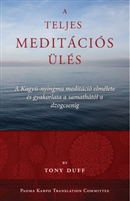
|

|
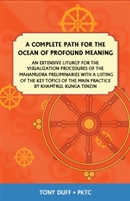
|

|
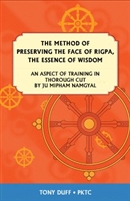
|
|
|
|
|
|
|
|
|
|
A book that features complete instructions on Kagyu-Nyingma meditation from sugata essence (buddha nature) through to Mahamudra and Dzogchen. This book is in Hungarian language; an English Language edition also is available in the store. The author is Tony Duff. Introduction, translations, ample footnotes, glossary, and book design by Tony Duff.
|
This book contains the text “'The Complete Path for the Ocean of Profound Meaning', An Extensive Liturgy for the Visualization Procedures of the Mahamudra Preliminaries with a Listing of the Key Topics of the Main Practice". It is a Drukpa Kagyu text commonly used as the practice text for the mahamudra preliminary practices. The text is by the famous Drukpa Kagyu head, Khamtrul III, Kunga Tenzin. Translation and book designby Tony Duff.
|
This book features the text "The Method of Preserving the Face of Rigpa, The Essence of Wisdom". Preservation is an important aspect of training in the Thorough Cut (Thregcho) practice of Dzogchen. The book with this specific teaching is one of several that are essential reading for practitioners of Thorough Cut and are available in this store. The text is by Ju Mipham Namgyal, the introduction, translations, ample footnotes, glossary, and book design by Tony Duff.
|

|
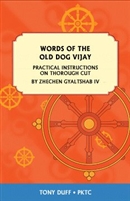
|

|
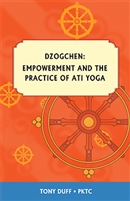
|

|

|
|
|
|
|
|
|
|
|
|
This book features a text by Zhechen Gyaltshab IV, the head of Zhechen Monastery in Tibet, on Thorough Cut (Thregcho) practice. It is strongly recommended for all Thorough Cut (Tregcho) practitioners. It is usually read in conjunction with the text "Way of the Realized Old Dogs" by Ju Mipham, which also is available in this shop. Introduction, translations, ample footnotes, glossary, and book design by Tony Duff.
|
Contains explanations by the author of empowerment and especially of the meaning of the fourth empowerment. Translations of several fourth empowerment sections of empowerment texts and the entire General Vase Empowerment by Jigmey Lingpa that is the root empowerment text of the Longchen Nyingthig system are included. There is also a letter by Dilgo Khyentse Rinpoche to a woman student, which in few words but very clearly sets out the practice of Dzogchen for a lay person. Introduction, translations, ample footnotes, glossary, and book design by Tony Duff.
|
The text in this book explains the basics of the Dzogchen practice of Thorough Cut (Thregcho). The text is by Zhechen Gyaltshab, one of the Gyaltshab line of tulkus who were the great heads of Zhechen monastery in Tibet, along with the Rabjam Rinpoches. The text is regarded as important reading for Dzogchen practitioners. Introduction, translations, ample footnotes, glossary, and book design by Tony Duff.
|

|
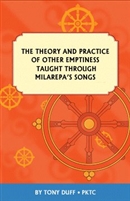
|

|
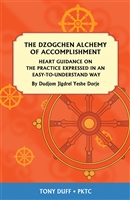
|

|

|
|
|
|
|
|
|
|
|
|
Khenpo Tsultrim Gyatso gave two public teachings in which he explained Other Emptiness according to a famous song of Milarepa that shows Other Emptiness as the final view. He also gave some private instructions to the author and a few of his close students. He then asked the author, Tony Duff, to compile all of the teachings into a single book and add further explanations to clarify. The result is this book, which contains extensive clarification in a long introduction as well as Milarepa's song and the Khenpo's explanations of it and Other Emptiness in general. Book is by Tony Duff.
|
Features the text “'Alchemy of Accomplishment', Instructions of Mountain Dharma, Heart Guidance on the Practice Expressed in an Easy-to-Understand Way Text” by Dudjom Rinpoche Jigdrel Yeshe Dorje. The text is a record of a teaching given to a group of people who had just entered a three year Dzogchen retreat. The text is very potent and is frequently used these days by Dzogchen practitioners. Introduction, translation, ample footnotes, glossary, and book design by Tony Duff.
|
A book that features complete instructions on Kagyu-Nyingma meditation from sugata essence (buddha nature) through to Mahamudra and Dzogchen. This book is in English; an Hungarian language edition also is available in the store. The author is Tony Duff. Introduction, translations, ample footnotes, glossary, and book design by Tony Duff.
|

|

|

|
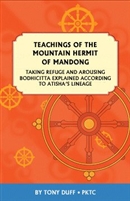
|

|

|
|
|
|
|
|
|
|
|
|
This book features explanations from several great Kagyu masters of Gampopa's important Mahamudra teaching called "The Five Part Mahamudra of the Kagyus". There are explanations from Drukchen Padma Karpo, Zhamar, Situ VIII, and others. A very complete oral teaching on the topic given by Tenga Rinpoche of Benchen Monastery is especially featured. Introduction, translations, ample footnotes, glossary, and book design by Tony Duff.
|
Features a text on taking refuge and arousing enlightenment mind (bodhichitta) by a hermit who lived in the mountains near Mandong, Tibet, in the 20th century. He was very famous for his compassion for and assistance given to the very poor people of the Mandong region who were suffering mightily because of the horrors of the Communist Chinese invasion of Tibet. His explanations in this text follow the teachings of Atisha's lineage, with a strong emphasis on taking refuge and arousing love and compassion for all. The great point of this text though, is his teaching on compassion. The title may not sound like much, but reading this book has brought Westerner's to tears because of his heart-felt explanations of other's sufferings. The book called "Hinting at Dzogchen" forms a useful companion to this book; it is available in this store. Introduction, translations, ample footnotes, glossary, and book design by Tony Duff.
|
This book features a text by the first Dodrupchen that has become the main preliminary practices text for Longchen Nyingthig practitioners. Several other texts by Tibetan Longchen Nyingthig masters are included so that the reader can have the clearest possible understanding of the practice text and how to use it for practice. There is also a commentary by Lama Tony Duff that clarifies points not contained in the other commentaries. Introduction, translations, commentary, ample footnotes, glossary, and book design by Tony Duff.
|

|
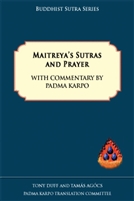
|

|
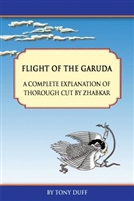
|

|

|
|
|
|
|
|
|
|
|
|
This book features two sutras of the Buddha that were discourses given for Maitreya's benefit. It also contains a popular prayer that was composed by Maitreya and a commentary to the prayer by the renouned Tibetan author, Drukchen Padma Karpo. Introduction, translations, ample footnotes, glossary, and book design by Tony Duff.
|
This book features a very popular text by the itinerant Tibetan yogi Zhabkar that gives a complete explanation of Thorough Cut practice (Tregcho). The text is very popular amongst Dzogchen practitioners. Verse and prose forms of the text are provided. Although the orginal is in verse, many Westerners find it easier to read the prose version, and this is explained fully in the introduction. Introduction, translation, ample footnotes, glossary, and book design by Tony Duff.
|
This book features records of many interviews with Gampopa and his heart disciples, Dusum Khyenpa, Phagmo Drupa, and others. It also has a translation of Gampopa's explanation that later became known as the "Four Dharmas of Gampopa". These collectively are regarded as the most important teachings preserved in Gampopa's Collected Works. Introduction, translations, ample footnotes, glossary, and book design by Tony Duff.
|

|
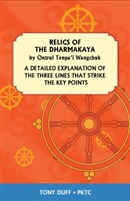
|

|
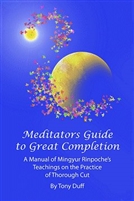
|

|

|
|
|
|
|
|
|
|
|
|
This book features a text that has a very detailed explanation of Garab Dorje's teaching called "The Three Lines that Strike the Key Points". The text is by Ontrul Tenpa’i Wangchuk, one of the great Dzogchen masters of Tibet. The text gives an unusually clear and detailed explanation of the Dzogchen practice of Thorough Cut (Thregcho). Therefore, it is strongly recommended reading for all practitioners of Dzogchen Thorough Cut (Tregcho). Introduction, translations, ample footnotes, glossary, and book design by Tony Duff.
|
This book contains a complete teaching by Mingyur Rinpoche on the path to enlightenment culminating in the Thorough Cut (Thregcho) teachings of Dzogchen. The book is ideal for those at all levels of Dzogchen practice. Introduction, translations, and book design by Tony Duff.
|
Features Shantideva's famous text Bodhisatvacaryavatara or "Entering the Bodhisatva Conduct", one of the favorite texts amongst followers of Buddhism. It is very popular because it presents a completely selfless view of how to live one’s life, which many have found very inspiring. Therefore, several translations of it have been made into English and other languages. The text is in very beautiful but terse verse, making it hard at times for the reader to understand. Therefore, Indian and Tibetan masters wrote commentaries to clarify its meaning. Many of them are long and hard to read, so have not been translated for Westerners. However, there is a very nice commentary by the great Tibetan author Padma Karpo, which takes the approach of inserting sufficient words into the text that its meaning is clarified while not adding so many words that they detract from the original. The book features the complete text of Shantideva set up for recitation and the text with commentary set up for study. Introduction, translation, ample footnotes, glossary, and book design by Tony Duff.
|

|

|

|
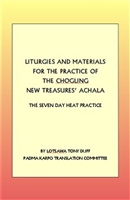
|

|

|
|
|
|
|
|
|
|
This book features the most important Dzogchen text by Jigmey Lingpa, with translations and explanations by Tony Duff. The book includes a vast number of footnotes that explain the details of the text which otherwise would not be accessible. The author received and practised the entire teaching a number of times in Tibet and checked every detail of the translation with the head khenpo of Dzogchen Monastery, resulting in a very accurate translation that conveys Jigmey Lingpa's unusual idiom exactly into English. Introduction, translations, ample footnotes, glossary, and book design by Tony Duff.
|
This book contains a complete set of texts and explanations of the Achala or Miyowa practice of Thrulkhor according to the Chogling New Treasures. The author was asked by Lama Goti, a well-known advanced practitioner of the system, to translate these materials and assemble them into a set for the sake of other Westeners wanting to do the practice. Translations, explanations, and book design by Tony Duff.
|

|